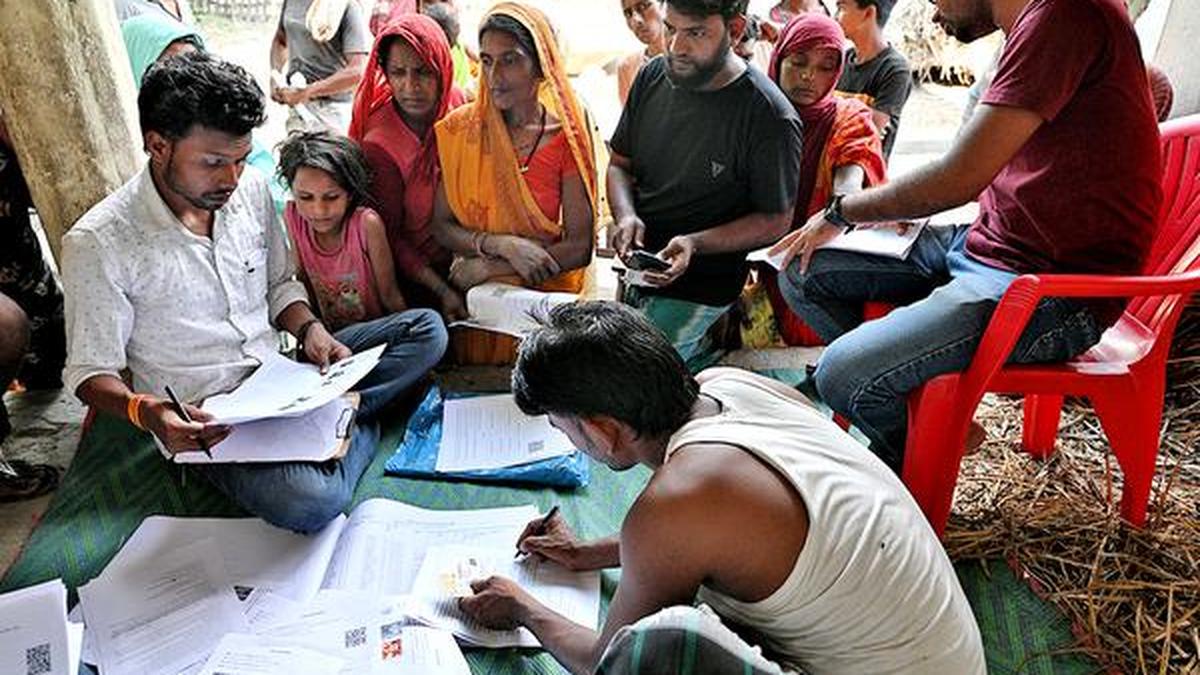As per the draft roll published on Friday, the number of voters in Bihar had dropped by 56 lakh.
| Photo Credit: SHASHI SHEKHAR KASHYAP
On August 1, the draft electoral rolls for Bihar, following the completion of the Special Intensive Revision (SIR) exercise, were released. A total of 7.24 crore electors are part of the latest electoral rolls — over 56 lakh electors fewer than the rolls prepared in January this year. According to the Election Commission of India, the voters who are not part of the August list have died, or are registered in two locations, or have permanently migrated out of Bihar, or are untraceable.
A district-wise analysis of the August electoral rolls shows that there was a tendency of a higher number of deletions from the rolls in districts with larger Muslim populations (2011 Census).

The chart below plots the difference in the number of electors in the August rolls compared to the January rolls, on the horizontal axis. On the vertical axis, we have plotted the districts’ Muslim population share.
In essence, we have plotted Muslim population against deletion in the SIR.The chart shows a moderate positive correlation (Pearson correlation r ≈ 0.43), indicating that districts with a higher Muslim population generally saw more deletions. But confirming whether Muslims were disproportionately deleted in the revised rolls calls for a more granular analysis.
On the other hand, there is negative correlation (r ≈ -0.46) in the change in electors compared to the share of Scheduled Caste (SC) population, district-wise. That is, districts with a higher SC population tend to have lower number of deletions. However, the earlier note of caution applies to this case as well. The chart below plots the difference in the numbers of electors on the horizontal axis and the district’s share of SC population.
A district-wise analysis of the August electoral rolls also shows that, in general, the higher the possible number of out-migrants from a district, the more the number of deletions from the roll. This confirms one of the ECI’s reasons for the deletions — out-migration.
We used female turnout relative to the electorate in the 2024 Lok Sabha elections as a proxy to measure district-wise out-migration in Bihar. We did this because, in 2024, Bihar stood out among the States that had a higher female-to-male voters ratio, despite having a lower female-to-male electorate ratio. The chart shows the ratio of male to female electors against the ratio of female-to-male voters (turnout).
This means that in Bihar, more women than men turned out to vote in absolute numbers even though there were more registered male electors. While there might be other factors explaining this gendered variation, the difference suggests that fewer men were available to vote despite being registered. Historically, Bihar is one of the largest sources of out-migration, which could explain the lower male turnout.
The chart below plots the district-wise ‘out-migration index’ on the vertical axis. This compares women’s share among all voters (male plus female) to their share among all electors in the 2020 polls. A positive value indicates more women voters turned out to vote in comparison to men despite higher male elector registration numbers. This is what we use as a proxy for higher out-migration. The chart also plots the difference in the number of electors on the horizontal axis. In essence, we plot out-migration against deletion in the SIR.
Note: Out-migration index for this chart was calculated using data from 2020 polls as gender-wise voting in Assembly seats was not available in 2024
The trend line shows that there is a moderate positive correlation (r ≈ 0.40). This means that in districts with higher out-migration, there seems to be more deletion of electors. However, this does not mean that deletions occurred exactly along gender lines, to remove possible male migrants from the rolls. In a subsequent Data Point, we will examine the deletions further in light of these findings.
Source: Election Commission of India, 2011 Census
Published – August 07, 2025 08:00 am IST
